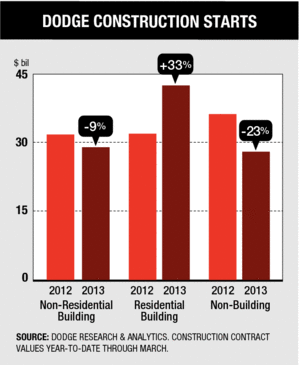
Construction Industry Starts Show No Gain Over First Quarter
The dollar value of total construction starts through the first quarter of this year was $100.5 billion, according to the latest Dodge data compiled by McGraw-Hill Construction. That nearly matches the $100.9 billion set during the first three months of 2012. The no-gain scenario is the result of a 9% decline in non-residential building and a 23% decline in non-building construction balancing out a 33% increase in residential work.
This year's first-quarter numbers could have fallen below 2012 if not for a 42% monthly jump in the non-building sector in March. That market got a big boost from a $940-million solar farm in Texas, in combination with smaller-scale projects, such as a $90 million biomass-to-energy powerplant in Hawaii. The volume of electric utility construction in March was still lower than 2012, down 64% from last year's average monthly pace, says Dodge's chief economist, Robert Murray.
Cement Manufacturer Agrees To Reduce Emissions at Plant
Portland cement producer CEMEX Inc., Lyons, Colo., will pay a $1-million civil penalty to resolve alleged violations of the Clean Air Act in a settlement reached on April 19 between the company and the U.S. Environmental Protection Agency. The Dept. of Justice, on behalf of the EPA, filed a complaint against CEMEX alleging that between 1997 and 2000, unlawful modifications the company made at its Lyons plant resulted in significant net increases of nitrogen oxide (NOx) and particulate-matter emissions.
As part of the settlement, CEMEX will install selective non-catalytic reduction (SNCR) technology, an advanced pollution-control technology designed to reduce NOx emissions. This step is designed to reduce those emissions by approximately 870 to 1,200 tons of NOx per year. The initial capital cost for installing the SNCR system is approximately $600,000, and the cost of injecting ammonia into the stack emissions stream, a key part of the process, is anticipated to be about $1.5 million per year.
Florida Utility Gets Smart
Florida's largest electric utility has completed the installation of 4.5 million "smart" meters, a project funded partly by $200 million in U.S. Dept. of Energy grants from the 2009 stimulus law. In announcing the finalization of the smart-grid enhancements, Juno Beach, Fla.-based Florida Power & Light Co. stated that it had invested $600 million in the effort, which aims to enhance the utility's ability to monitor its electrical grid and identify problems and outages more quickly.
"Situational awareness plays an important role in improving the reliability and resiliency of the grid," stated Patricia Hoffman, an assistant secretary with the DOE who participated in a public ceremony commemorating the project's completion, according to FPL. The smart meters also will allow customers to monitor their power usage remotely. When President Obama announced the $3.4 billion in smart-grid grants in 2009, he cited analysis by the Electric Power Research Institute that said smart-grid technologies could cut electricity use by 4%.
OSHA's New Crane Rule Affects Underground, Demolition Work
The U.S. Occupational Safety and Health Administration has issued a final rule that applies the requirements of a 2010 standard for cranes and derricks in construction to demolition work and underground construction. The final rule, which takes effect on May 23, applies the same crane rules to underground construction and demolition that are being used by other construction sectors and eliminates the separate cranes and derricks standard currently used for underground and demolition work, OSHA says.
Bill Hillman, CEO of the National Utility Contractors Association, says, "Most of our members are already in compliance with the requirements, either for safety reasons or because of state requirements." He notes that some firms have subcontracted out any crane work to ensure they are in compliance with the 2010 standard.


Post a comment to this article
Report Abusive Comment